Exploring AlUla’s Ancient Treasures
The rising sun’s rays slowly flood the two-millennia-old red sandstone steps ascending toward the heavens. One by one, each tier of the façade begins to change colour, bringing the features of the Tomb of Lihyan, son of Kuza, into focus. Three cavetto cornices cascade down the front, meeting the pin-straight pilasters crowned with iconic Nabatean horned capitals – inspiration for countless Corinthian capitals across the Greco-Roman world. Perched at the apex of the Hellenic pediment, just above the entrance, is an eagle (now headless) with its wings spread wide, a symbol associated with the Nabatean god Dushara.
“If you look beneath the eagle, you will see a rough line where the work stopped,” explains my tour guide, Abdur Razzak, who looks to be around 30 and is wearing a white thobe so pristine I can’t find a single crease. “We know that Lihyan is mentioned in the Nabatean inscriptions as a general in the army, and in A.D. 106, when the Romans invaded, perhaps Lihyan participated in the war and got killed. Maybe this is the reason he never finished his own tomb.”
Red rock outcroppings frame a sleek pool at Habitas AlUla in Saudi Arabia’s Ashar Valley
A naturally formed passageway at Jabal Ithlib, in the ancient Nabatean city of Hegra
The fact that the tomb’s façade is unfinished does nothing to diminish the formidable majesty of what the locals call Qasr al-Farid, or the Lonely Castle, for the way it stands alone in the barren, harsh desert of the Valley of AlUla, a vast region in northwestern Saudi Arabia rich with archaeological wonders.
I can’t quite believe I am finally here, after waiting for years. Like the rest of the world’s nearly two billion Muslims, I have a special relationship with Saudi Arabia, home of Islam’s two holiest cities. I performed the last hajj before the global pandemic, alongside 2.5 million fellow pilgrims. I also used to live in the Kingdom, where I absorbed its unique culture.
By the time of my last visit, in 2019, Saudi women had been granted the right to drive for the first time and no longer needed a male guardian to leave the house. Unmarried foreign men and women were allowed to check into a hotel room together; and the rules forcing businesses to close their doors during the five daily prayers were relaxed. This was all forbidden in the past under Saudi Arabia’s ultra-conservative interpretation of Islam. Even the fearsome mutawa – the religious police tasked with enforcing these rules – were conspicuous by their absence.
These new freedoms stem from the Kingdom’s Vision 2030, a drive to diversify Saudi Arabia’s oil-dependent economy and gradually update age-old norms. Consequently, I found myself travelling through a country in the midst of a cultural and industrial revolution. During my exploration, I discovered stretches of unspoiled Red Sea coastline, swam in waters alive with virgin coral, and viewed ancient rock art from 5,500 BC as new visitor paths were being laid. However, while I did visit the region of AlUla, I wasn’t able to see the historic Nabatean sites, which remained closed to all visitors.




